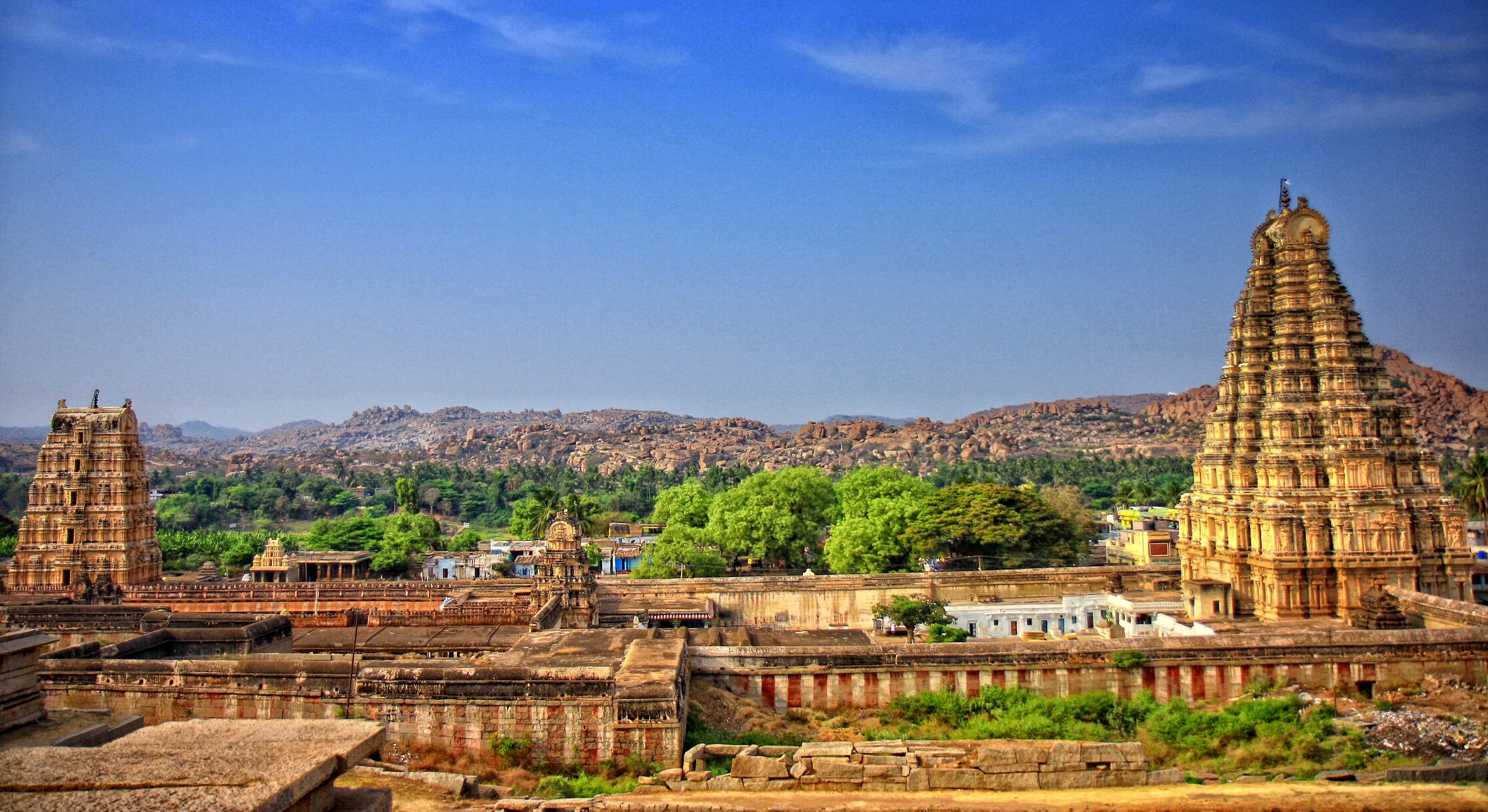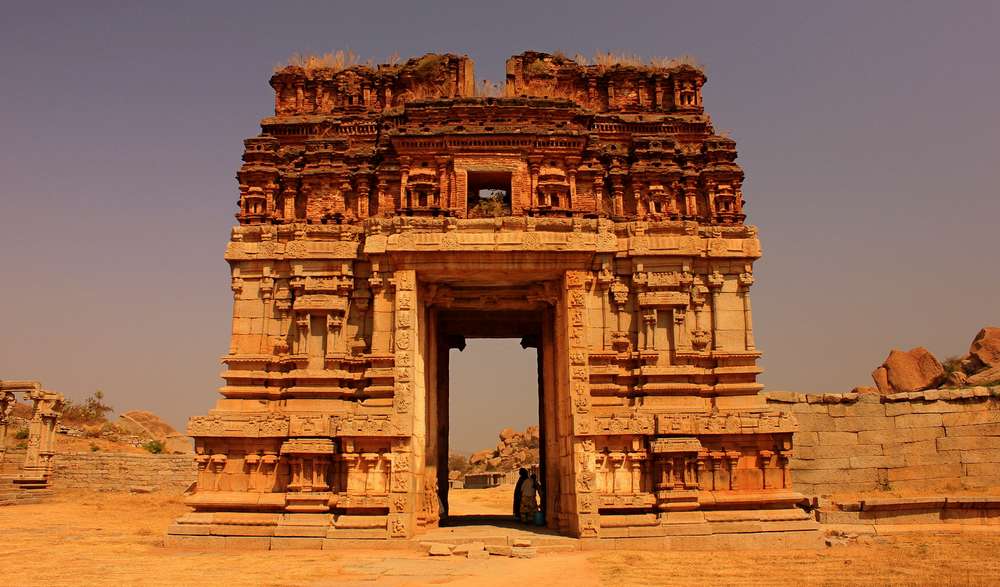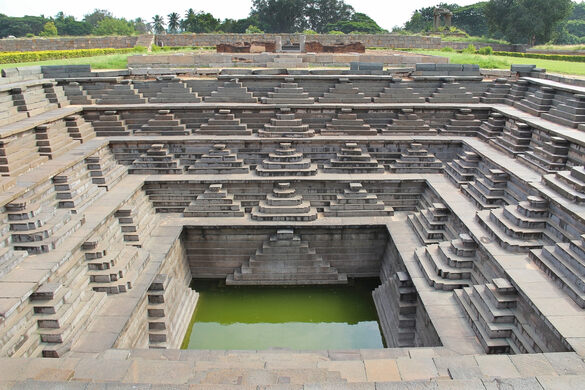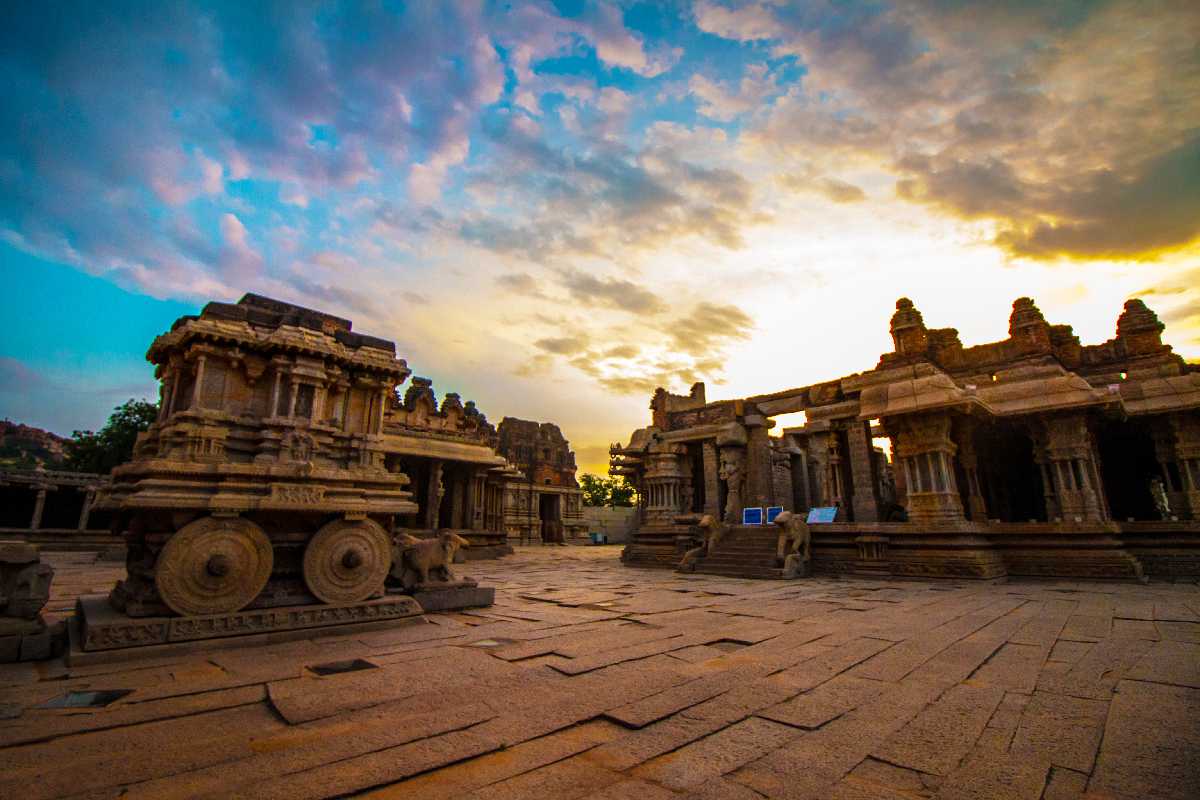Hampi, popularly known as temple complex of India. It became the centre of the Hindu Vijayanagara Empire capital in the 14th century. Chronicles left by Persian and European travellers, particularly the Portuguese, state Hampi was a prosperous, wealthy and grand city near the Tungabhadra River, with numerous temples, farms and trading markets. By 1500 CE, Hampi-Vijayanagara was the world's second-largest medieval-era city after Beijing, and probably India's richest at that time, attracting traders from Persia and Portugal.

The Vijayanagara Empire was defeated by a coalition of Muslim sultanates; its capital was conquered, pillaged and destroyed by sultanate armies in 1565, after which Hampi remained in ruins.
Virupaksha temple and market complex
The Virupaksha temple is the oldest shrine, the principal destination for pilgrims and tourists, and remains an active Hindu worship site. Parts of the Shiva, Pampa and Durga temples existed in the 11th-century; it was extended during the Vijayanagara era. The temple is a collection of smaller temples, a regularly repainted, 50-metre (160 ft) high gopuram, a Hindu monastery dedicated to Vidyaranya of Advaita Vedanta tradition, a water tank (Manmatha), a community kitchen, other monuments and a 750 metres (2,460 ft)-long ruined stone market with a monolithic Nandi shrine on the east end.

The temple faces eastwards, aligning the sanctums of the Shiva and Pampa Devi temples to the sunrise; a large gopuram marks its entrance. The superstructure is a pyramidal tower with pilastered storeys on each of which is artwork including erotic sculptures. The gopuram leads into a rectangular court that ends in another, smaller gopuram dated to 1510 CE. To its south side is a 100-column hall with Hindu-related reliefs on all four sides of each pillar. Connected to this public hall is a community kitchen, a feature found in other major Hampi temples. A channel is cut into the rock to deliver water to the kitchen and the feeding hall. The courtyard after the small gopuram has dipa-stambha (lamp pillar) and Nandi.
Krishna temple, market, Narasimha and linga
The Krishna temple on the other side of Hemakuta hill, is about 1 kilometre (0.62 mi) south of Virupaksha temple. In front of the ruined temple is a long market street, also referred to locally as the bazaar.

Between the colonnaded stone shop ruins is a broad road that allowed chariots to transport goods to and from the market, and hosted ceremonial functions and festive celebrations.

To the north of this road and middle of the market is a large Pushkarani—a public utility-stepped water tank with an artistic pavilion in its centre. Next to the tank is a public hall (mandapa) for people to sit.
Achyutaraya temple and market complex
The Achyutaraya temple is about 1 kilometre (0.62 mi) east of Virupaksha temple and a part of its sacred centre is close to the Tungabhadra River. It is one of the four largest complexes in Hampi. The temple is unusual because it faced north. It is dedicated to Vishnu. The temple had an outer gopuram leading into a courtyard with a 100-column hall and an inner gopuram leading to the Vishnu temple.

On each side of each pillar in the 100-column hall are reliefs of avatars of Vishnu; other deities such as Shiva, Surya, Durga; scenes of daily life—rishi, amorous couples, jokers; people in yoga asanas; people in namaste poses; and Vijayanagara emblems.
Hemakuta hill monuments
The Hemakuta hill lies between the Virupaksha temple complex to the north and the Krishna temple to the south. It is a collection of modestly sized monuments that are the best-preserved examples of pre-Vijayanagara and early-Vijayanagara temples and construction.

The site has several important inscriptions, is easily accessible and provides views of the some parts of Hampi and the fertile, agricultural valley that separates the sacred centre from the urban core with its royal centre.
Hazara Rama temple
The Hazara Rama temple, referred to as the Ramachandra temple in inscriptions, occupied the western part of the urban core in the royal centre section of Hampi. This temple was dedicated to Rama of the Ramayana fame, and an avatar of Vishnu. It was the ceremonial temple for the royal family. The temple is dated to the early 15th century and is attributed to Devaraya I. The temple's outer walls portray the Hindu Mahanavami (Dasara) and the spring Holi festival procession and celebrations in parallel bands of artwork.

The lowest band shows marching elephants, above it are horses led by horsemen, then soldiers celebrated by the public, then dancers and musicians, with a top layer depicting a boisterous procession of the general public. The depiction mirrors the description of festivals and processions in surviving memoirs of Persians and Portuguese who visited the Vijayanagara capital.
Water infrastructure
The Square Water Pavilion, also called the Queen's Bath, is in the south-east of the royal centre. It has a pavilion, a water basin and a method of moving fresh water to it and taking away wash water and overflows. The basin is enclosed within an ornate, pillared, vaulted bay. Nearby are ruins of the aqueduct. The modern name of this building, the Queen's bath, is probably a misnomer because this was a public bath for men and travellers. The building's interior arches show influence of the Indo-Islamic style, reflecting an era in which Hindu and Muslim arts influenced each other in India.

Archaeological excavations in 1990 revealed twenty-three wells and cisterns in the Hampi-Vijayanagara metropolis. Of these, thirteen were found outside the city walls in the suburbs, and ten inside. Of these were twelve at roadsides, eight near temples, ten in residential areas and two were used for irrigation within the urban core. More water structures were found in Daroji valley for agriculture. According to archaeologists Kathleen Morrison and Carla Sinopoli, the Hampi water infrastructure was for the use of travellers, rituals, domestic use and irrigation.
According to mythology, the maiden Parvati resolves to marry the loner ascetic Shiva. Her parents learn of her desire and discourage her, but she pursues her desire. Shiva is lost in yogic meditation, oblivious to the world; Parvati appeals to the gods for help to awaken him and gain his attention. Indra sends the god Kama—the Hindu god of desire, erotic love, attraction, and affection—to awake Shiva from meditation. Kama reaches Shiva and shoots an arrow of desire. Shiva opens his third eye in his forehead and burns Kama to ashes. Parvati does not lose her hope or her resolve to win over Shiva; she begins to live like him and engage in the same activities—asceticism, yogin and tapasya—awakening him and attracting his interest. Shiva meets Parvati in disguised form and tries to discourage her, telling her Shiva's weaknesses and personality problems. Parvati refuses to listen and insists in her resolve. Shiva finally accepts her and they get married.

According to Sthala Purana, Parvati (Pampa) pursued her ascetic, yogini lifestyle on Hemakuta Hill, now a part of Hampi, to win and bring ascetic Shiva back into householder life. Shiva is also called Pampapati. The river near the Hemakuta Hill came to be known as Pampa river. The Sanskrit word Pampa morphed into the Kannada word Hampa and the place Parvati pursued Shiva came to be known as Hampe or Hampi.